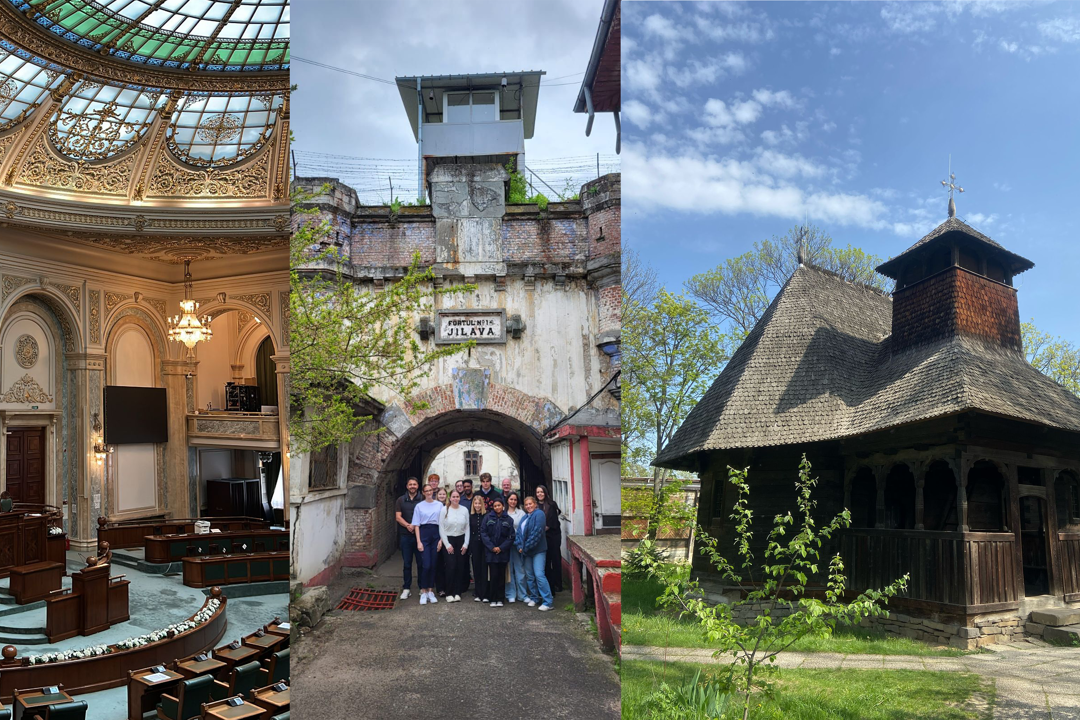School of Social Sciences associate professor Geraldine Lee-Treweek examines the history and relevance of June's Gypsy, Roma and Traveller (GRT) History Month.
June is Gypsy, Roma and Traveller (GRT) History Month, #GRTHM, although during Covid-19 this has probably not been on many people’s radar. During recent weeks, the Black Lives Matter Campaign has galvanised social awareness around race and ethnicity issues and for GRT people this has been a positive, with many aligning themselves with the movement. But one could ask, is there any room for a Gypsy, Roma and Traveller History Month and, frankly, what is the need?
Surely, GRT communities are just like everyone else and do not require any particular discussion, recognition or regard? Indeed, some reading may feel that GRT are a ‘problem’, viewing us through the lens of the media construction of our communities or through well-worn stereotypes that permeate the social and political imagination. I use ‘us’ because I have Romani heritage and have written this, fully aware that most will not know about GRT ethnic groups.
Who are Gypsy, Travellers and Roma Communities: the centrality of a history of movement, unsettlement, exclusions
GRT communities are diverse, many of which can be tracked back to the movement of nomadic groups from North India around 1200 years ago. These are most commonly referred to as Roma, Romani, Rom and Gypsy (Open Society Foundations 2013). These groups arrived in the UK around the 1500s, where they joined a host of other indigenous travelling groups, such as Irish Travellers, Welsh Kale, Scottish and English Travellers.
The term gypsy has been used as a term of abuse for centuries and today is being reclaimed by some but rejected by others; it is best not used unless the individual/group involved have indicated they are happy with the term. All of these groups are officially considered ethnic groups, with protected characteristics. There are also those who have more recently chosen to live an unsettled lifestyle, such as New Age Travellers and Show People - these groups are not considered ethnic groups, although they commonly experience discrimination similar to GRT communities.
Returning to the movement of Romani communities from North India, their migration took them across Europe, moving originally as a lifestyle and to seek better opportunities but becoming a protective strategy. Examination of historical documents around the situation of GRT people in the early to mid-medieval period illustrate the extent of their exclusions. Living on the edge of societies as ‘newcomers’, they were incorrectly defined as ‘Egyptians’, which became shortened to ‘Gypsies’. Centuries of hate, discrimination and abuse followed, with various countries criminalising gypsy status, sometimes even offering bounties for their murder.
In Romania, gypsies became enslaved in the middle ages, a situation that was only officially abolished in the late 1800s. A pan-European history of exclusion separated gypsies out so that they were treated as liminal people ‘out of place’, not of the settled community, and poverty, deprivation and lack of opportunities became the norm. GRTs invariably had to create their own work, becoming entrepreneurial, creating the means to live in an excluding continent. Likewise, movement was a protection that enabled them to leave when work and food were short or abuse meant it was not safe to stay; moving became simultaneously part of our culture but also a necessary response to hate.
During the Second World War, this hate was brought to its ultimate conclusion when the GRT communities of Europe were targeted for genocide by the Nazis. The scientific method was deployed to justify hate and abuse by its use to argue that GRT people were physically, psychologically and morally inferior. Estimates vary but between 500,000 to 1,500,000 GRT people were sent to concentration camps or murdered in their homes/the community by the Nazis, in a time known by many GRT people as ‘The Devouring’ (something you may know as ‘The Holocaust’). But after the war, the suffering of the GRT communities was not recognised - we were excluded from memorials to those who died in the campus and the killings were excised from the European historical, social and political landscape and memory for nearly 40 years.
Today, many European and UK GRT communities have settled or live in encampments stipulated by state authorities (in the UK these are often not the traditional ubiquitous stopping places of old, but smaller numbers of Council validated sites, typically with poor facilities). But mobile or not, strong cultural features are shared within and between many GRT groups. There are, for instance, over 50 recognised GRT languages in Europe, some based on Sanskrit, others based on indigenous languages and amalgamating many linguistic and cultural influences.
In the UK for instance, some GRTs speak British Romanes (aka Angloromani), which shares similarities to other GRT languages across Europe. There are diverse cultural mores around health and wellbeing, civil order and society, family and home, religion or none at all. Sadly, there is often fear or distrust of authority, which has come from years of prejudice, discrimination that continues today and there is a shared memory and experience of exclusion.
Discrimination and Exclusion Today
Most people are unaware of the history of people of GRT heritage and their continued struggles across the continent of Europe and beyond (the GRT diaspora is spread around the world, often due to trying to escape discrimination, sometimes from being forcibly banished). Recent statistics make stark and sobering reading. In Europe there are serious problems of hate crime and abuse by state actors (such as Police and military). Roma health status and quality of life metrics are, across the continent of Europe, lower than that of other non-Roma communities.
As a result of the overall poor Roma health status, overall life expectancy for Roma community are estimated to be between 5 and 20 years lower than for other demographic groups across Europe (European Commission 2014) (European Public Health Alliance 2014:5). Across Europe, the average age of GRT child drop out from school ranges between 10 and 12. Murder of Roma by individuals and state forces is high. Anti-gypsyism has been argued by EU commenters, critical race theorists and GRT organisations to be ‘the last form of acceptable racism in Europe’ (Travellers Times 2018).
In the UK, The Equality and Human Rights Commission (2018) note that the average lifespan of a person of GRT background in the UK is ten years less than that of the UK national average. However, if you look at the statistics, it is GRT men who do worse than women in terms of life span. The EHRC also highlight that GRT mothers are twenty times more likely to experience the death of one of their children than mothers generally in the UK.
In education there are high levels of school none attendance and/or drop out, when children do stay on to their GCSES they are well behind all other ethnic groups in terms of achievement. It is probably therefore no surprise that lack of opportunities ensue, including less chance of going to college (higher risk of becoming defined as NEET, not in education, employment or training) and only 2% of GRT people attend Higher Education (EHRC 2018). The labour market is also problematic - for one there are no role models, but secondly, there is likewise no recognition of different cultural values and for those few who make it into and through HE, the only coping strategy is often to hide their backgrounds.
Change is slowly happening though. For instance, a burgeoning GRT pride movement is beginning to help to challenge the negative experiences of exclusion, along with the shame and fear (forced upon GRT people through their continual majority historical debasement, discrimination and abuse), with a positive recognition of our cultures and histories. Examples of the work of the GRT pride movement include the push for recognition of The Devouring (memorials, social policy and political recognition of GRT victims and survivors) and greater public prominence of diverse GRT language, music, clothing and dress, traditional skills and contribution to societies.
(Bad) History in the Making?
Current UK government policy is premised on residency and on settlement, and there is a strong negative public notion of nomadic lifestyles or mobility in general. Policy, likewise, codifies negativities against those who move. Currently there is a government push against unauthorised encampments. This forgets that during the Thatcher era traditional travelling sites were closed and the land often sold for new houses, forcing travelling peoples onto the roadsides, car parks, parkland and so forth and creating deep-seated conflicts over land, space and lifestyle between settled and travelling communities.
These are conflicts that have never been addressed or healed, in part because no extra provision has been made to make up for the loss of over a thousand traditional sites back then. This history is often forgotten and that it effectively criminalised living on the move. The current move against unauthorised encampments again forgets what was taken away and never given back; the prioritising of a culture of settlement over a culture of movement, continues. The experience and lives of GRT peoples, on the road or otherwise, are still not understood and GRT history month is part of this.
So GRT history month is helping to redress matters? The reality is that one month in a year does not deal with centuries of inequalities, slavery, abuse, social/political exclusion and genocide. The problem is these issues still resonate today and are ongoing, from accounts in continental Europe of police beating children during lockdown, to the refusal of public bodies across many countries of Europe (including the UK) to make basic provision (by this I mean access to fresh water) on some traveller sites during Covid-19, to the increased unemployment rates in these diverse communities. The health and mortality disparities continue but this is an invisible group; more must be done to raise profile and understanding and to support GRT communities.
This blog has outlined key areas of abuse and discrimination against GRT communities and, in doing so, I hope has indicated the reasons why a GRT history month is vital. Indeed, I am all for it, as long as the very real and pressing issues of discrimination, prejudice, hate, abuse, unequal life chances and public policy that exclude and criminalise these groups, are not forgotten for the rest of the year.
References:
Murry, J. (2020) ‘Gypsies and Travellers in England Left without Water during Covid-nineteen‘ The Guardian 4th June 2020, available at: https://www.theguardian.com/world/2020/jun/04/gypsies-and-travellers-in-england-left-without-water-during-lockdown Accessed 10th June 2020
Open Society Foundations (2013) Gypsies, Roma and Travellers: an animated history. available at: https://www.opensocietyfoundations.org/voices/gypsies-roma-travellers-animated-history Accessed June 2020
Travellers Times Blog (2018) Anti-Gypsyism: the last acceptable form of racism in Europe?, available at: https://www.travellerstimes.org.uk/features/anti-gypsyism-last-acceptable-form-racism-europe Accessed June 2020
For more information on Gypsy, Roma and Traveller History Month, please see:
The Traveller Movement Website: https://travellermovement.org.uk/campaigns/gypsy-roma-and-traveller-history-month
Traveller’s Times Website: https://www.travellerstimes.org.uk/heritage/gypsy-roma-and-traveller-history-month
The Knowledge Exchange Blog: https://theknowledgeexchangeblog.com/2019/06/10/a-road-less-travelled-celebrating-gypsy-roma-and-traveller-history-month-part-1/





